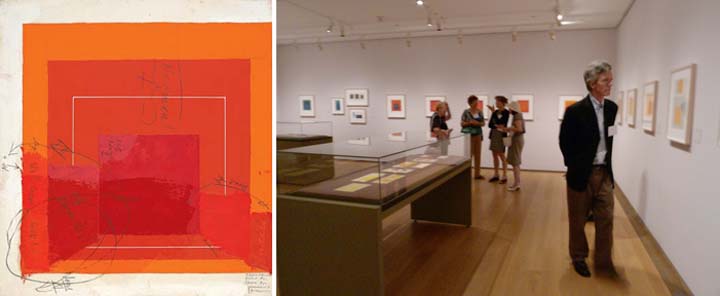Josef Albers at The Morgan Library
Josef Albers (1888-1976), whose explorations of color are currently on view at the Morgan Library and Museum, began making art as a child in Germany. His father was a house painter, set painter, and decorator. From him, young Albers learned the craft of art, and took pleasure in painting imitation wood grain and marble. His ambition was to become an artist, but at his family’s urging, he became an art teacher, with 6 to 14-year-old children as his first students in a one-room schoolhouse.
As a teacher, Albers was on to the magic and trickery of colors—how they behave differently, in fact become different colors in different adjacencies. His life’s work was getting his students to learn how to see, and to articulate their observations, in paint. And his own masterwork was his 25-year study, Homage to the Square.
At the Morgan, Josef Albers in America: Painting on Paper presents his explorations on the subject starting with small studies he did on blotting paper in 1947, after he had emigrated to America from Nazi Germany, ending with paintings and prints from the Homage series, with 60 or so pieces in between.

Above left: Josef Albers, Color Study for White Line Square, oil on blotting paper with gouache, pencil and varnish, The Josef and Anni Albers Foundation, courtesy The Morgan Museum and Library. Right: Scene from media preview, photo: Peggy Roalf.
The precision of his work is mind-boggling, from the hard-edge forms executed in paint using a palette knife to his penciled notes on the content of the color; proportions of each color used; paint manufacturers; and parallel experiments on different sheets of papers. His restless experimentation with paint colors straight from the tube has a mad-scientist appeal; by eliminating one kind of experimentation, that of mixing colors, he engaged in a pursuit surely more difficult to sustain.
Josef Albers’ contributions to art education in America, which were controversial at first, have, by now, become seamlessly integrated into art school curricula. For very young artists, a recent picture book, with art by Julia Breckenreid (AI-28) and text by Natasha Wing (a neighbor of Albers during her childhood) will nicely fill in the gap between finger painting and greater endeavors. An Eye For Color: The Story of Josef Albers (Henry Holt) starts out with this simple truth: “Josef Albers saw art in the simplest things.” The artwork and text together make complex ideas, such as optical illusions, a fun aspect of learning the skill of keen observation. The interaction of color, the mood a color can create, the way an accident can change the course of the work, are all covered. “For twenty-seven years, Josef created images of squares—more than a thousand of them! For him there was no end to what he could learn about color.” This book is a good read for artists of all ages.
Josef Albers in America: Painting on Paper continues through October 14 at the Morgan Library and Museum, 225 Madison Avenue, at 36th Street, NY, NY. On Friday, October 5th, there will be a 7 pm screening of Josef and Anni Albers: Art is Everywhere. Free.


